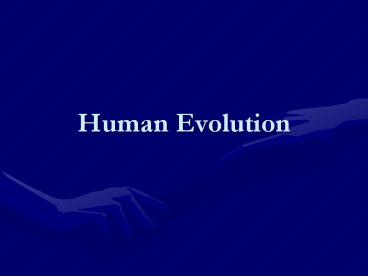Human Evolution - PowerPoint PPT Presentation
1 / 27
Title:
Human Evolution
Description:
Human Evolution ... – PowerPoint PPT presentation
Number of Views:599
Avg rating:3.0/5.0
Title: Human Evolution
1
Human Evolution
2
Human Classification
- Domain Eukarya
- Kingdom Animalia
- Phylum Chordata
- Class Mammalia
- Order Primate
- Family Hominidae
- Genus Homo
- Species sapiens
3
- Animals
- multicellular eukaryotic organisms that ingest
other organisms - Chordates
- Animals that at some point during their
development have - a notochord (long flexible rod that runs along
the dorsal axis of the body in the future
position of the vertebral column) - a dorsal, hollow nerve cord
- pharyngeal slits or clefts
- and a muscular, post-anal tail.
4
(No Transcript)
5
- Mammals
- amniotes with mammary glands that produce milk
- Primates
- Include lemurs, monkeys, chimpanzees, gorillas
and humans - Main characteristics
- Opposable thumbs
- Forward facing eyes
- Well-developed cerebral cortex
- Omnivorous
6
(No Transcript)
7
(No Transcript)
8
- Hominidae
- The great apes
- Includes orangutans, gorillas, chimpanzees and
humans - Larger than monkeys
- Relatively long arms, short legs, no tail
- Larger brain in proportion to body size
- More flexible behavior than other primates
9
(No Transcript)
10
- Homo
- Genus that includes extinct species such as
Homo habilis, Homo erectus, and
Homo neanderthalensis as well as Homo sapiens, - Had larger brains than predecessors, such as the
Australopithicus - Sapiens
- Modern humans
- Homo sapiens idaltu extinct lived 160,000
years ago in Pleistocene Africa slight skull
differences from - Homo sapiens sapiens only extant subspecies of
Homo sapiens
11
- Australopithicus
- 1974 Lucy
- discovered
12
Homo Characterized by Larger Brain Size
13
Homo sapiens sapiens
Homo sapiens idaltu
14
Major Physical Features Defining Humans as
Primates
- Grasping limbs, with long fingers and a separated
opposable thumb - Mobile arms, with shoulder joints allowing
movement in 3 planes, and the bones of the
shoulder girdle allowing weight to be transferred
via the arms
15
Major Physical Features Defining Humans as
Primates, contd.
- Stereoscopic vision, with forward facing eyes on
a flattened face, giving overlapping fields of
view. Each eye gets a slightly different view of
the world. The brain fuses the two views to get
depth information.
16
Major Physical Features Defining Humans as
Primates
- Skull modified for upright posture
17
What is the Evidence that Humans are a Species of
Ape that Spread to Colonize New Areas?
- Closest existing relatives of humans are
orangutans from Southeast Asia and gorillas and
chimpanzees of Africa.
18
Biochemical Evidence that Humans are a Species of
Ape that Spread to Colonize New Areas
- Study of amino acid differences for proteins and
mitochondrial DNA show humans are more closely
related to chimps and gorillas than to
orangutans.
19
Three phylogenetic trees were reconstructed based
on the DNA sequences of
- 4700 bp of mitochondrial DNA
- the testis specific protein on the Y chromosome
- noncoding regions of the ß-globin gene
All three trees show that human and chimp DNA
sequences are more similar on average than are
human and gibbon or human and orangutan
sequences.
20
Biochemical Evidence that Humans are a Species of
Ape that Spread to Colonize New Areas
- These biochemical data support the theory that
human ancestors split from ancestors of the
chimps and gorillas in Africa. - The molecular data also allow approximate dating
of the splits of various groups of humans - Between Africans and other humans 140,000 y.a.
- Between Europeans and Japanese 70,000 y.a.
21
Ancestors of modern humans migrated out of Africa
less than 500,000 y.a.
- Older fossil hominids found out of Africa must
have been the result of earlier migrations, and
modern humans are not descended from these
hominids.
22
Anatomical Evidence that Humans are a Species of
Ape that Spread to Colonize New Areas
- Neoteny when infant characteristics persist in
the adult - Adult humans show similarities in appearance to
baby apes, including flat faces, large brain to
body size ratio, upright heads, and little body
hair. - This suggests that human evolution may have
involved a slowing down of development with long
childhood, delayed puberty, and retention of
juvenile characteristics into adulthood.
23
Neoteny
24
Neoteny and Brain Size
- The slowing down of development in the genus Homo
included continued brain growth after birth, as
opposed to cessation of growth after birth. - Consequences of increased brain size include
- increased capacities for learning, complex
thought, and memory - possibility of language and complex tool
manufacture - increased amount of energy required to use brain
25
Anatomical Evidence that Humans are a Species of
Ape that Spread to Colonize New Areas Bipedalism
- Bipedalism is walking on two legs
- All apes are capable of bipedalism, but are not
as nearly as adept as humans are
26
Bipedalism Adaptations Involved
- Foramen magnum, hole in skull through which brain
and spinal cord connect, moved forward, allowing
the head to balance on the backbone - Arms became shorter and less powerful
- Legs became longer and stronger
- Knee changed to allow the leg to straighten fully
- Foot became more rigid, with longer heel, shorter
toes and a non-opposable big toe
27
Bipedalism Some Consequences
- Collecting food from bushes may be easier
- Walking long distances while carrying food,
water, infants, tools, or weapons is possible - Tree climbing is more difficult
- Go to Evolution Library The Transforming
Leap, from Four Legs to Two - Read the article, "The Transforming Leap, from
Four Legs to Two." - Summarize the different hypotheses offered to
explain the development of bipedalism and the
evidence that supports or refutes each.































